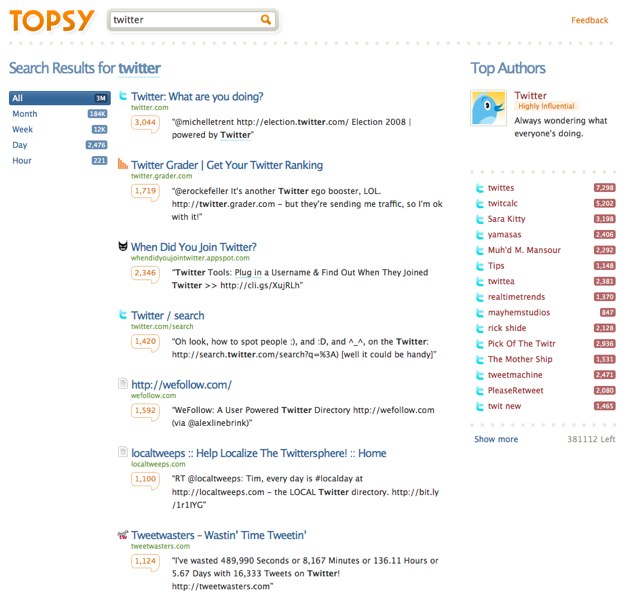New search engine Topsy, which has been in stealth development for three years, launches, well, now.
Before Google, search engines like AltaVista determined relevance based on how well a web page matched the query. Then came Google, which views the web as a network of documents. Today, all search engines analyze linking behavior around the web. When a web page is linked to a lot, it’s given more influence than other pages competing for attention around the same topics/keywords. Jeff Jarvis summed it all up nicely in 2005 “In this new world, links are currency. Links grant authority. Links build branding. Links equal value.” There’s lots more to it, but the notion that links create value is what drives Internet search.
Well, it’s no longer 2005. Back then blogs were giving Google fits because of how fast and irregularly they updated. Google had to make decisions on how often to index pages. Indexing is expensive, so there’s a tradeoff. Ping servers and blog search engines rose briefly to fill the niche, but Google indexes most popular blogs so often that those blog search engines are no longer much better.
Now, though, we have so much real time content being created that Google and the other engines can’t keep up. Most of this content is on Twitter, but FriendFeed, Facebook, Digg and lots of other services are adding to it, too. The result – more and more people are doing searches on Twitter Search in addition to Google. For me, someone who’s obsessed with news and stuff that’s happening right now, Twitter search is about 25% of my total Internet searches. The ratio keeps going up over time.
That’s where Topsy comes in. It’s not strictly speaking a real time search engine like Scoopler, which we wrote about earlier this month. Topsy is just a search engine. That has a fundamentally new way of finding good results: Twitter users.
The 30 million or so Twitter users are an army of little content-finding machines. Topsy says those users are sending tens of thousands of unique links per day to interesting things around the Internet.
Some of those users have more influence than others. And some links are sent by lots of Twitter users, others just sent once. Those links, combined with the information in the Twitter message itself, is what Topsy uses as the basis of its search engine.
And the results are…amazing.

New stuff in particular percolates up very quickly. A search for Facebook, for example, shows lots of news about the funding that was announced earlier today. And the links are sorted by those that Twitter users are sending around the most, weighted in favor of links sent by more influential Twitter users. You can sort results over all time (going back to September 2008), last month, week, day or hour. For all time, top results for Facebook are the Facebook site and developer site, among others. But in the last hour and day, it’s all about the funding news.
Results show popular links but also the most influential users tweeting about that topic. Click on that user and you’ll see all their tweets about the topic. Here’s the results for TechCrunch and Facebook, for example.
User influence is a hot topic, of course. Topsy isn’t looking at the number of followers. Rather, Influence is gained when others retweet links you’ve sent out. And when you retweet others, you lose a little Influence. So the more people retweet you, the more Influence you gain. So, yes, retweets are the new currency on the web. Told you.
Topsy was founded in 2006 and has raised nearly $15 million to date in venture and debt funding. More information on the funding and founders is on the CrunchBase page for Topsy.
Here’s a video where the Topsy founders give an introduction to the service and how it works:






























Comment